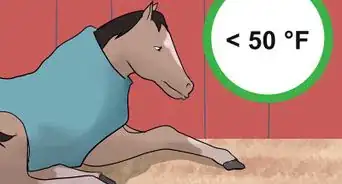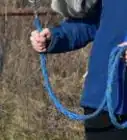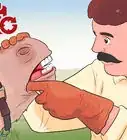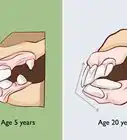This article was co-authored by Pippa Elliott, MRCVS. Dr. Elliott, BVMS, MRCVS is a veterinarian with over 30 years of experience in veterinary surgery and companion animal practice. She graduated from the University of Glasgow in 1987 with a degree in veterinary medicine and surgery. She has worked at the same animal clinic in her hometown for over 20 years.
This article has been viewed 175,433 times.
A 'join up' is a trust activity developed by avid horseman Monty Roberts. Joining up involves using a loose schooling activity and developing awareness of a horse's body language cues. The technique aims to give the horse a choice between accepting the trainer as a herd leader or not. The principle involved is similar to a mare teaching her foal, where the foal accepts the mother's gentle authority. If you're interested in developing a stronger trust bond with your horse via completely non-violent training, the join-up method might be what you’re looking for.
Steps
Learning the Methodology
-
1Gain access to a circular pen or small arena. The key to success is a quiet, calm environment where the horse's attention is completely on the trainer. You can achieve this by working within the confines of a circular pen. Choose a pen large enough for the horse to lunge in a circle around the trainer but without being so big that the horse can avoid the trainer’s presence.
- An alternative to a circular pen is a small arena or school. However, this has the disadvantage of having corners where the horse may retreat and stop moving. Obviously a circle has no corners, so the horse does not have the same incentive to come to rest in a corner.
-
2Get a long lunge line. The only equipment the trainer needs is a long lunge line, which the trainer uses to gently tap the horse's back legs. This gives the horse a reason to move forward as he tries to evade the tapping of the line.
- The trainer should not use a lunging whip or any other method of incentivizing the horse to go forward. The whip represents a fearful stimulus, which the horse could associate with the trainer. This can ultimately impede the building of trust between the two.
Advertisement -
3Go in with patience. Another important point to understand is that if the horse does not "get" what you are trying to do, then you should stop the session. There is nothing to be gained, and everything to lose by frustrating and confusing the horse. Simply start again another day.
- In the meantime, carefully review your gestures, body language, and tone of voice (covered more in Part 2) to improve your technique and correct an inadvertent mixed messages you were sending out.
Joining Up with the Horse
-
1Calm down. Going into it with a nervous or angry attitude is not going to get you anywhere. The Join Up depends on the horse viewing you as the calm at the center of the storm, so you must present a safe and trustworthy person to approach. Take a few deep breaths and make sure the horse knows you're confident and relaxed.
- Remember that the horse will almost always mimic you. If you're jumping everywhere and shouting, the horse will respond by running and acting aggressively.
- Maintain relaxed body language and don't show fear. If you show fear or hesitation, then the horse will take this as a sign of submission from you, and it will take a lot longer to join up.
-
2Show the right body language. Stand tall but in a non-aggressive, non-confrontational manner. This means making your movements soft and fluid rather than tense and jerky. Keep your hands close to your body.
- A horse may take fright at objects perceived as being waved around, so presenting a uniform silhouette poses less of a threat.
-
3Use a calm voice. Use a sing-song, happy, calm tone of voice. As soon as you shout or berate the horse, you have broken the Join Up because the horse understands your attitude as well as the tone and timbre of your voice.
-
4Bring your horse to an enclosed paddock or ring on a 30 feet (9.1 m) line. Your aim at this stage is to familiarize the horse with the arena, so the animal can see it holds no surprises. You also want to show the horse you are calm and not a threat.
-
5Lead the horse around the pen. The horse might be a little scared or confused. Lead the animal around the safe, enclosed area for a few minutes. Change direction a few times as you lead to set yourself as "leader."
- You may also want to talk to the horse in a gentle voice as you do this to help calm the animal.
-
6Move toward the center of the pen while encouraging the horse to move away. You want to encourage the horse to move toward the perimeter. To do this, you may need to firmly "shoo" the horse away. You do not want to frighten the animal, but merely point out that it needs to be somewhere else, in the same way a mother may send her foal away.
- The process of moving the horse away presents you as lead mare.
-
7Position the line. You will still have the longline attached to the horse’s halter. As the horse moves away from you, throw the line out behind the animal while keeping hold of the clip. Position the line to the far side of the horse. This will cause the line to trail alongside the animal’s body, behind the tail, and across the hind quarters.
- Flicking on the long line now has the effect of geeing the horse forward. Encourage the horse to move in a circle around you.
-
8Work the horse in circles around you. Continue to push the horse on gently, working in circles around you. As the horse becomes familiar with what's expected, you will see its body language start to change. The horse may angle its head toward you and twitch the inside ear (the one closest to you) toward you as if awaiting instructions. This is a sign that the horse is ready to negotiate his position and do what you want.
-
9Continue to push the horse on gently. You will see the horse angle his head to you, which is a sign he is ready to negotiate his position according to what you want.
- After 5 or 6 circuits (if using a 50-foot diameter pen), change direction by blocking the horse using body language, but not actually getting in the way. After another 5 or 6 circuits change direction again, and start to coil the line and maybe drop eye contact down to the neck/shoulder.
-
10Look for other signs from the horse. Other signs the horse is paying attention and looking for your guidance include making the circle smaller, turning the inside ear toward you, licking or chewing at the air, and lowering the head perhaps even touching the nose to the ground as if looking for somewhere to graze.[1]
- The fact that the horse is relaxed but looking to you for instruction means the horse has started to trust you. Now you are both ready to move onto the next phase and test that trust.
-
11Change your body language. When you see these signs, drop eye contact completely and soften your body language. Try bringing the hand nearest the horse across your stomach with fingers closed. Turn your back and take a few steps away from the horse while remaining alert (watch out he/she may lose attention on you while you are not looking). This will cause the horse to come toward you slowly and 'join up'.
- If everything goes according to plan, when you turn your back and walk away, the horse will step toward you and follow. This is the same way a foal follows the mother when she moves off. You want to reward this behavior so that the horse is more likely to repeat it in future.[2]
- If things don't go to plan and the horse ignores you, start working the animal in a circle again and go back to the beginning. However, if the horse is starting to tire, stop and try again another day.
-
12Reward the horse. You can rub between the eyes or offer a nice stroke on the neck. This is how horses naturally groom each other or assure a lower status horse. They do not approach the lead mare unless she is very relaxed and not exerting her authority.
-
13Get the horse to follow. Stand next to the horse on the near side, facing forward. Walk off and circle around the horse’s nose to the right. The horse will follow when you have established that you are the leader. Complete a small circle and reward the horse. Do this in both directions.
Warnings
- Always be patient with your horse and don't always expect results instantly.⧼thumbs_response⧽
- This is a guideline. Horses are not robots that can be "fixed" each one is different with a personality. Respect that and don't expect too much the first time. Your horse is trying its best to understand.⧼thumbs_response⧽
- Never do join-up with more than one horse in the ring because they may be confused and may compete for position in the herd.⧼thumbs_response⧽
- Horses can be unpredictable; always be aware of this for safety.⧼thumbs_response⧽
- Stay close to safe places for you to get away to in case the horse runs or kicks at you. If it's an outdoor arena, it's a good idea to have a fence that you can quickly crawl under or jump over.⧼thumbs_response⧽
- Never attempt Join Up with a stallion, colt, or a hand–reared horse. You may give the wrong signals to a stallion and a hand–reared horse may not understand your signals.⧼thumbs_response⧽
Things You'll Need
- Halter
- 30 feet (9.1 m) line
- Closed paddock or ring
- A "safe" place to escape from an aggressive horse
References
About This Article
To join up with a horse, you'll need access to a small, circular pen or arena and a long lunge line. To get started, lead your horse into the pen using the line, and walk it around the pen for a few minutes. Then, throw the line out behind your horse while still holding onto the clip, and flick it to encourage your horse to move forward. Continue to gently push your horse around the circle, and change directions after 5 or 6 trips around. Once the horse starts paying attention to you and looking for guidance, it should start following you when you walk away. For more tips from our Veterinary co-author, like how to reward your horse, read on!
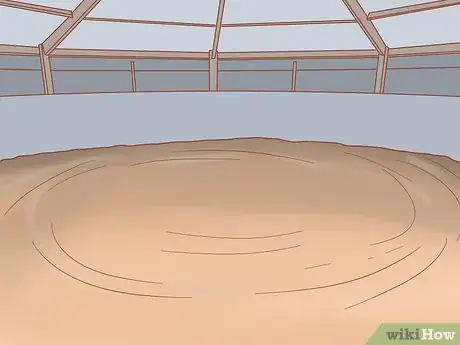
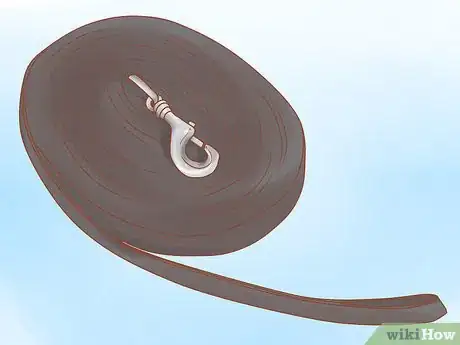


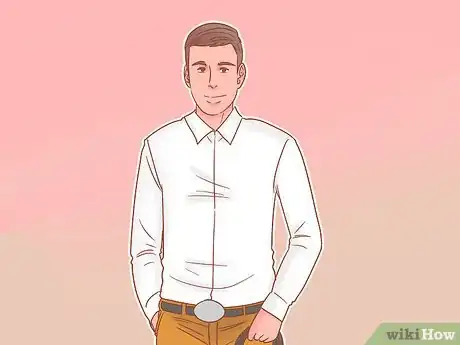

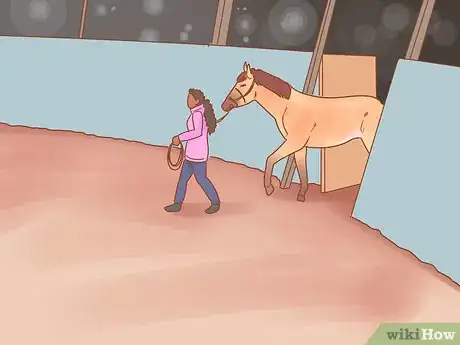

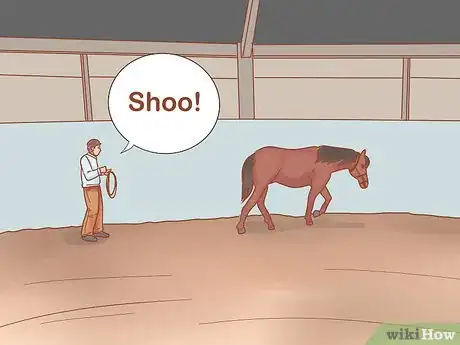
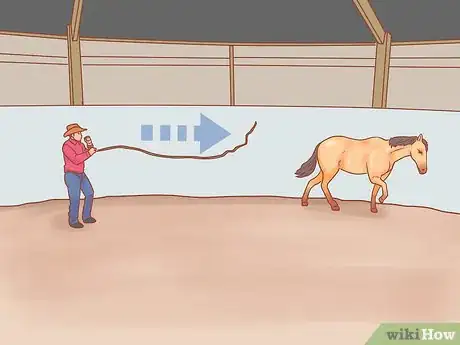
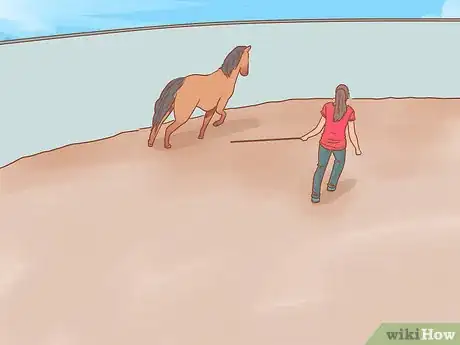
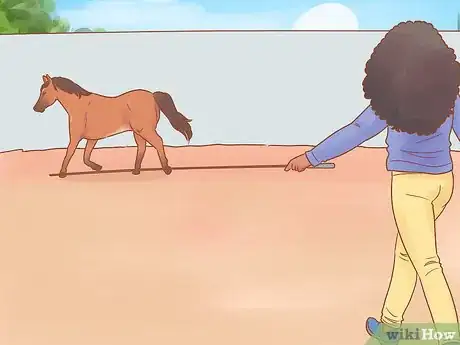
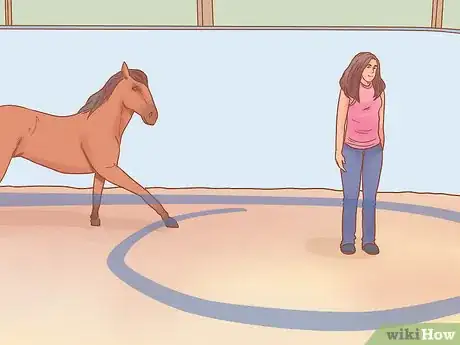
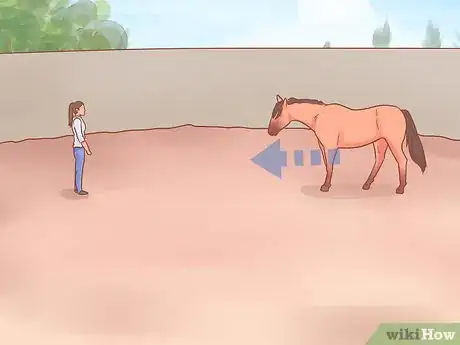
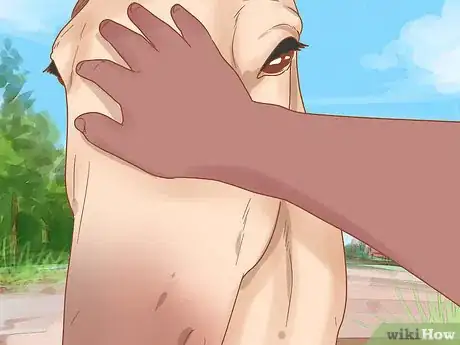
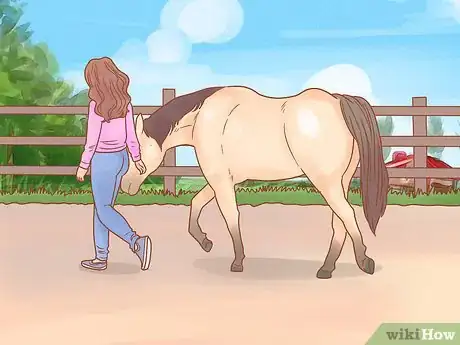



-in-Horses-Step-4-Version-2.webp)


